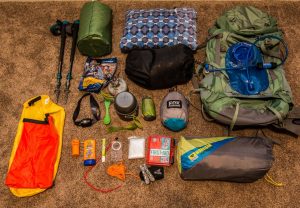Top Backpacking Essentials for Outdoor Adventures: Embarking on a backpacking trip requires meticulous preparation. This guide delves into the crucial gear, clothing, food, water, and safety considerations necessary for a successful and enjoyable outdoor adventure. From selecting the right backpack and footwear to planning nutritious meals and mastering essential first-aid, we’ll equip you with the knowledge to confidently tackle any trail.
Understanding the nuances of each essential item – from high-quality, moisture-wicking clothing to reliable water purification methods and comprehensive first-aid kits – will significantly enhance your experience and ensure your safety. We’ll cover practical tips for minimizing weight, optimizing packing, and navigating various terrains, ultimately empowering you to embrace the wilderness with confidence and preparedness.
Top Backpacking Essentials
Backpacking necessitates careful consideration of what you carry. Weight is a primary concern, but safety and comfort are paramount. Choosing the right clothing is crucial for maintaining warmth, dryness, and overall well-being throughout your adventure, regardless of unexpected weather changes. This section details essential clothing items and considerations for backpacking trips.
Essential Backpacking Clothing Items
Selecting appropriate clothing involves layering to adapt to changing weather conditions. This allows you to add or remove layers as needed, maintaining optimal comfort and preventing overheating or hypothermia. The following list Artikels key clothing items:
- Base Layer: Moisture-wicking thermal underwear (top and bottom) made from merino wool or synthetic materials like polyester. These materials pull sweat away from your skin, keeping you dry and warm.
- Mid Layer: A fleece jacket or lightweight down jacket provides insulation and warmth. Choose a jacket that is packable and compressible.
- Outer Layer: A waterproof and windproof shell jacket and pants are essential for protection against rain, snow, and wind. Look for breathable fabrics to prevent overheating.
- Hiking Pants or Convertible Pants: Durable, quick-drying pants are ideal. Convertible pants offer versatility, allowing you to zip off the legs for warmer weather.
- Hiking Socks: Choose moisture-wicking socks made from merino wool or synthetic materials. Avoid cotton socks.
- Warm Hat: A hat will help retain body heat, especially important in cold conditions.
- Gloves or Mittens: Choose lightweight gloves or mittens for dexterity and warmth.
- Sun Hat: Essential for sun protection, even on cloudy days.
Moisture-Wicking Fabrics and Hypothermia Prevention
Moisture-wicking fabrics are critical for preventing hypothermia. Hypothermia occurs when your body loses heat faster than it can produce it, leading to dangerously low body temperature. Cotton clothing absorbs sweat and retains moisture, which then chills the body. Moisture-wicking materials, on the other hand, pull sweat away from the skin, keeping you dry and allowing your body to maintain its core temperature.
This is crucial in preventing hypothermia, especially in cold and wet conditions. Merino wool and synthetic fabrics like polyester are excellent choices for base layers and socks.
Hiking Sock Comparison
Different hiking socks offer varying levels of cushioning, breathability, and durability.
- Merino Wool Socks: Excellent moisture-wicking properties, naturally odor-resistant, durable, but can be more expensive than synthetics.
- Synthetic Socks: Typically less expensive than merino wool, quick-drying, and offer good moisture-wicking properties. However, they may not be as comfortable or durable as merino wool.
- Cotton Socks: Should be avoided for backpacking due to their tendency to absorb and retain moisture, leading to blisters and cold feet.
- Blended Socks: Combine the benefits of merino wool and synthetics, offering a balance of comfort, moisture-wicking, and durability.
Minimizing Clothing Weight and Bulk
Minimizing weight is crucial for backpacking. Choose lightweight, compressible clothing items. Consider packing versatile clothing that can be used in multiple situations. For example, convertible pants can be worn as pants or shorts, and a fleece jacket can provide warmth in multiple situations. Avoid overpacking; only bring what is absolutely essential.
Properly drying wet clothing before packing it is also important for minimizing weight and preventing mold and mildew.
Top Backpacking Essentials
Planning a backpacking trip requires careful consideration of various factors, and among the most crucial are food and water. Proper planning in these areas directly impacts your enjoyment, safety, and overall success on the trail. Neglecting these essentials can lead to discomfort, exhaustion, and even dangerous situations. This section will detail essential considerations for food and water management during your backpacking adventure.
Sample 3-Day Backpacking Meal Plan
A well-planned meal plan prioritizes lightweight, non-perishable foods that provide sufficient energy for your activities. This sample plan emphasizes simplicity and ease of preparation. Remember to adjust portion sizes based on your individual needs and activity level.
- Day 1: Breakfast – Oatmeal with dried fruit and nuts; Lunch – Trail mix (nuts, seeds, dried fruit); Dinner – Freeze-dried backpacking meal (e.g., pasta with pesto).
- Day 2: Breakfast – Granola bars; Lunch – Peanut butter and crackers; Dinner – Freeze-dried backpacking meal (e.g., chicken and rice).
- Day 3: Breakfast – Energy bars; Lunch – Jerky and cheese; Dinner – Instant mashed potatoes with dehydrated vegetables.
Water Purification Methods
Safe drinking water is paramount during backpacking. Several methods exist for purifying water, each with its own advantages and disadvantages. Selecting the appropriate method depends on factors such as water source quality, personal preference, and weight considerations.
- Boiling: This is a reliable method that kills most harmful bacteria and viruses. Bring water to a rolling boil for at least one minute at sea level (longer at higher altitudes). Simple and effective, but requires fuel and time.
- Water Filter: Filters remove sediment, bacteria, and protozoa. They are lightweight and relatively fast, but may not remove all viruses. Regular maintenance and filter replacement are essential.
- Water Purifier (UV or Chemical): UV purifiers use ultraviolet light to kill microorganisms, while chemical treatments (e.g., iodine or chlorine dioxide tablets) disinfect water. These methods are lightweight and effective, but chemical treatments can alter the taste of water.
Essential Cooking Equipment
Efficient and lightweight cooking equipment is crucial for preparing meals on the trail. This list includes essential items to consider.
- Lightweight stove and fuel: Choose a stove that is compact and efficient, such as an integrated canister stove or alcohol stove. Ensure you have sufficient fuel for your trip’s duration.
- Cook pot and/or pan: Select a pot or pan made of lightweight, durable material, such as titanium or anodized aluminum.
- Utensils: A lightweight spork or spoon, and a small knife are sufficient for most backpacking meals.
- Biodegradable soap and sponge: For cleaning cookware.
Estimating Food and Water Needs
Accurate estimation of food and water requirements is critical for a successful backpacking trip. This involves considering trip duration, intensity, and individual metabolic rates.
A general guideline is to consume approximately 3000-4000 calories per day for strenuous activities. Water consumption should be at least 1 gallon (3.8 liters) per day in moderate conditions, increasing with higher temperatures and activity levels.
For example, a 3-day, strenuous backpacking trip might require approximately 9000-12000 calories and 3-4 gallons (11.4-15.1 liters) of water. These are estimates, and adjustments should be made based on individual needs and weather conditions. It’s always better to overestimate than underestimate.
Top Backpacking Essentials
Backpacking offers unparalleled opportunities for adventure and connection with nature, but preparedness is paramount. A well-stocked backpack is crucial, but equally important is understanding safety protocols and possessing the knowledge to handle unexpected situations. This section focuses on essential safety and first-aid measures for a successful and secure backpacking trip.
Essential First-Aid Supplies for Backpacking
A comprehensive first-aid kit is non-negotiable for any backpacking trip. The contents should address common injuries and illnesses encountered in the wilderness, where access to immediate medical care is limited. The kit should be lightweight yet robust enough to handle various scenarios.
| Category | Items | Quantity | Notes |
|---|---|---|---|
| Wound Care | Sterile gauze pads, antiseptic wipes, adhesive bandages (various sizes), medical tape, antibiotic ointment | Multiple of each | Choose lightweight, individually wrapped items. |
| Pain Relief | Ibuprofen, acetaminophen | Sufficient for trip duration | Consider individual needs and potential allergies. |
| Blister Treatment | Moleskin, blister pads | Several | Preventative measures are crucial; treat blisters promptly. |
| Other Essentials | Tweezers, scissors, safety pins, instant cold compress, personal medications (if applicable), insect repellent, sunscreen | As needed | Personalize this section based on individual needs and potential hazards. |
Navigation in Challenging Terrain
Effective navigation is vital, especially in unfamiliar or challenging terrain. A combination of map, compass, and GPS device provides redundancy and ensures you can find your way even if one system fails.Before embarking on your trip, thoroughly study your chosen route on a topographic map. Learn to orient your map using a compass and understand how to take bearings and follow them.
Practice using your GPS device to record your location and track your progress. In challenging conditions, prioritize map and compass skills as GPS devices can be unreliable or fail due to battery depletion or signal loss. Always carry a backup navigation tool.
Preventing and Responding to Wildlife Encounters
Wildlife encounters are a possibility in any wilderness setting. Prevention is key; make noise while hiking to avoid surprising animals, store food properly to avoid attracting unwanted visitors, and never approach or feed wild animals. Familiarize yourself with the local wildlife and their behavior. Carry bear spray in bear country and know how to use it effectively.
If you encounter a wild animal, maintain a safe distance, avoid direct eye contact, and slowly back away. If attacked, fight back using whatever means are available.
Informing Someone of Your Itinerary
Always inform a reliable person of your detailed itinerary, including your planned route, expected return time, and emergency contact information. This ensures someone knows where to look for you if you are overdue or encounter an emergency. Regular check-ins via satellite phone or text message can provide additional peace of mind, especially on longer or more remote trips.
Top Urban Destinations
Exploring vibrant urban nightlife offers a unique opportunity to experience the pulse of a city, immersing oneself in its culture and energy. From bustling bars to intimate live music venues, the diverse offerings cater to a wide range of tastes and preferences. Understanding the nuances of each city’s nightlife scene is key to maximizing the enjoyment and ensuring a safe and memorable experience.
Top Five Urban Destinations with Vibrant Nightlife
The following list highlights five cities renowned for their exceptional and diverse nightlife experiences, each possessing a distinct atmosphere and offering a range of entertainment options. These cities represent a global spectrum of nightlife styles, from the classic elegance of European capitals to the innovative and eclectic scenes of modern metropolises.
- Berlin, Germany: Berlin’s nightlife is legendary for its eclectic mix of techno clubs, underground bars, and alternative venues. The city’s history is interwoven with its nightlife, creating a unique atmosphere of freedom and creativity.
- New York City, USA: NYC offers a diverse and multifaceted nightlife experience, ranging from sophisticated rooftop bars with stunning city views to intimate jazz clubs in Greenwich Village and massive dance clubs in various boroughs. The sheer scale and variety are unparalleled.
- London, England: London’s nightlife scene is characterized by its sophisticated pubs, trendy cocktail bars, and world-class live music venues. From traditional pubs in historic neighborhoods to cutting-edge clubs in Shoreditch, London caters to all tastes.
- Tokyo, Japan: Tokyo’s nightlife is a blend of traditional and modern, offering everything from karaoke bars and izakayas (Japanese pubs) to sleek clubs and themed bars. The city’s vibrant energy extends late into the night, creating a unique atmosphere.
- Barcelona, Spain: Barcelona’s nightlife is known for its lively atmosphere, particularly along Las Ramblas and in the Gothic Quarter. The city boasts a wide range of bars, clubs, and live music venues, often spilling out onto the streets, creating a vibrant and energetic atmosphere.
Nightlife Experiences in Each Location
Each city offers a unique spectrum of nightlife experiences. Berlin, for instance, is renowned for its techno clubs, often operating in former industrial spaces, while New York City provides a far broader spectrum, from intimate jazz clubs to large-scale dance venues. London’s pubs offer a more traditional social experience, while Tokyo’s izakayas provide a uniquely Japanese cultural immersion.
Barcelona’s nightlife often spills onto the streets, creating a more communal and energetic experience.
Comparison of Berlin and New York City Nightlife
Berlin and New York City, while both globally renowned for their nightlife, offer distinctly different experiences. Berlin’s nightlife is heavily influenced by its underground techno scene, often characterized by large, warehouse-style clubs playing electronic music until sunrise. The atmosphere is frequently more raw and experimental. New York City, in contrast, provides a much broader range of options, from sophisticated cocktail bars to intimate jazz clubs to massive dance clubs.
Its nightlife reflects the city’s immense diversity and caters to a wider spectrum of tastes and preferences. The scale of New York’s nightlife is also significantly larger than Berlin’s.
Safety Considerations for Urban Nightlife, Top backpacking essentials for outdoor adventures
Enjoying urban nightlife safely requires awareness and responsible behavior. Staying in well-lit and populated areas, avoiding walking alone late at night, and using reputable transportation services are crucial. Keeping valuables secure, being mindful of one’s surroundings, and consuming alcohol responsibly are also essential for ensuring a safe and enjoyable experience. Knowing emergency contact information and having a plan for getting home safely are also vital aspects of responsible nightlife enjoyment.
Top Urban Destinations
Exploring the world’s vibrant cities offers a plethora of experiences, and shopping undoubtedly stands as a significant highlight for many travelers. From luxury boutiques to bustling street markets, each city boasts a unique shopping landscape reflecting its culture and history. This section focuses on five urban destinations renowned for their exceptional shopping experiences, categorized by style to help you plan your next retail adventure.
Top Five Urban Shopping Destinations
The following list highlights five cities offering diverse and captivating shopping experiences, categorized by their dominant shopping styles. Each location offers a unique blend of luxury, vintage, and street style, catering to a wide range of tastes and budgets.
- Paris, France (Luxury & Vintage): Known for its high fashion and timeless elegance, Paris offers a blend of luxury boutiques and vintage treasures.
- Milan, Italy (Luxury & Designer): A global hub for high fashion and design, Milan boasts iconic designer brands and sophisticated shopping experiences.
- Tokyo, Japan (Street Style & Technology): Tokyo is a vibrant tapestry of street style, cutting-edge technology, and unique fashion trends.
- New York City, USA (Luxury, Vintage & Street Style): A melting pot of styles, NYC offers everything from high-end department stores to vintage finds and trendy street wear.
- London, England (Vintage, Street Style & High Street): London’s shopping scene is diverse, blending vintage markets with high street brands and unique independent boutiques.
Best Shopping Areas in Each City
Each city offers specific areas best suited for particular shopping styles.
- Paris: The Champs-Élysées for luxury brands, Le Marais for vintage and independent boutiques, and Saint-Germain-des-Prés for a mix of high-end and unique finds. Expect to find designer clothing, luxury accessories, antique furniture, and unique art pieces.
- Milan: The Quadrilatero della Moda (Fashion Quadrilateral) for luxury designer boutiques, Via Montenapoleone for high-end fashion, and Brera for independent designers and artisan crafts. Expect to find Italian leather goods, high-fashion clothing, and bespoke tailoring.
- Tokyo: Harajuku for unique street style and youth fashion, Shibuya for trendy department stores and electronics, and Ginza for luxury brands and high-end department stores. Expect to find cutting-edge technology, unique fashion accessories, and innovative street wear.
- New York City: Fifth Avenue for luxury department stores, SoHo for designer boutiques and trendy stores, and the Lower East Side for vintage clothing and unique finds. Expect to find a vast array of styles, from classic American brands to cutting-edge designer collections and vintage clothing.
- London: Oxford Street for high street brands, Carnaby Street for trendy boutiques and street style, and Portobello Road Market for vintage clothing and antiques. Expect to find a mix of high street fashion, unique vintage finds, and bespoke tailoring.
Weekend Shopping Itinerary: Tokyo
This itinerary focuses on a weekend shopping trip to Tokyo, highlighting key areas and potential purchases. Day 1:
- Morning: Explore Harajuku, focusing on Takeshita Street for its unique street style and quirky fashion. Potential purchases include unique accessories, handmade jewelry, and trendy clothing.
- Afternoon: Visit Shibuya, focusing on department stores like Shibuya 109 for trendy fashion and electronics retailers. Potential purchases include the latest technology gadgets, cosmetics, and fashionable clothing.
- Evening: Enjoy dinner in Shibuya, followed by exploring the vibrant nightlife.
Day 2:
- Morning: Explore Ginza, focusing on luxury department stores and high-end boutiques. Potential purchases include luxury watches, designer handbags, and high-end cosmetics.
- Afternoon: Visit a local market for unique souvenirs and artisan crafts. Potential purchases include traditional Japanese crafts, ceramics, and local delicacies.
- Evening: Enjoy a final dinner, reflecting on your shopping spree.
Tips for Navigating Crowded Markets and Finding Unique Items
Navigating crowded markets and finding unique items requires a strategic approach.
- Research beforehand: Identify specific markets and stores that align with your interests to optimize your time.
- Go early: Beat the crowds and have a better selection of items.
- Bargain respectfully: In some markets, bargaining is expected, but always be polite and respectful.
- Explore beyond the main streets: Venture into smaller side streets and alleys to uncover hidden gems and unique finds.
- Don’t be afraid to ask questions: Engage with vendors to learn more about their products and their stories.
Top Urban Destinations
Exploring cities offers a diverse range of experiences beyond the typical tourist trail. This section delves into unique urban adventures, architectural marvels, diverse culinary scenes, and practical tips to enhance your city exploration.
Unique Urban Experiences
Engaging with a city’s unique character goes beyond shopping and nightlife. These experiences offer a deeper understanding of the local culture and history.
- Participate in a city-wide scavenger hunt: Many cities offer organized scavenger hunts that lead participants through hidden alleys, historical landmarks, and local neighborhoods, revealing the city’s secrets and fostering a sense of exploration and discovery. These hunts often incorporate puzzles and challenges, adding an element of playful competition.
- Attend a local festival or cultural event: Immerse yourself in the city’s vibrant culture by attending local festivals, celebrating everything from food to art and music. These events provide a glimpse into the city’s soul and offer opportunities to interact with locals.
- Take a cooking class focusing on regional cuisine: Learn to prepare authentic local dishes from experienced chefs, gaining insights into the culinary traditions of the city. This hands-on experience provides a deeper appreciation for the city’s gastronomic landscape.
- Visit a local museum dedicated to a unique aspect of the city’s history: Many cities house museums dedicated to specific aspects of their history, offering a deeper understanding of the city’s evolution and its unique character. This provides an alternative to the more general history museums.
- Explore a hidden urban park or green space: Discover tranquil oases within the bustling city by exploring hidden parks and green spaces, offering a respite from the urban hustle and a chance to appreciate nature within the city limits. These spaces often reveal unexpected beauty and serenity.
Urban Architecture Tours in New York City
New York City offers a diverse range of architectural styles, reflecting its rich history and evolution. These tours provide different perspectives on the city’s built environment.
- A tour focusing on skyscrapers and modern architecture: This tour would explore the iconic skyscrapers of Midtown Manhattan, examining their architectural styles, construction techniques, and historical context. It would delve into the evolution of skyscraper design, from early steel-frame structures to modern glass and steel marvels.
- A walking tour highlighting brownstones and historic neighborhoods: This tour would focus on the charming brownstones and historic neighborhoods of Greenwich Village or Brooklyn Heights, showcasing the architectural details and historical significance of these residential areas. It would explore the evolution of these neighborhoods and the architectural styles that define them.
- A specialized tour concentrating on Art Deco architecture: This tour would delve into the Art Deco buildings that are prevalent throughout the city, showcasing their unique stylistic features and historical context. It would highlight the influence of Art Deco on New York City’s skyline and its lasting impact on urban design.
Unique Street Food and Markets
Exploring local street food and markets offers a delicious and immersive way to experience a city’s culture.
- Bangkok, Thailand: Bangkok’s street food scene is legendary, with vibrant night markets offering a vast array of dishes, from Pad Thai and green curry to exotic fruits and desserts. The Chatuchak Weekend Market is a sprawling labyrinth of food stalls, offering a sensory overload of sights, smells, and tastes.
- Mexico City, Mexico: Mexico City boasts a rich culinary heritage, with street vendors offering tacos al pastor, esquites (corn salad), and elotes (grilled corn). Markets like Mercado Medellín offer a diverse range of traditional Mexican foods and ingredients.
- Istanbul, Turkey: Istanbul’s street food scene is equally captivating, with vendors selling simit (sesame bread rings), döner kebab, and Turkish delights. The Spice Market (Egyptian Bazaar) offers a sensory feast of fragrant spices, herbs, and dried fruits.
City Travel Hacks
Employing these strategies can significantly enhance your city exploration experience.
- Utilize public transportation: Public transportation systems, such as subways and buses, are often the most efficient and cost-effective way to navigate a city, allowing you to explore a wider range of areas.
- Download offline maps and translation apps: These tools are invaluable for navigating unfamiliar streets and communicating with locals, ensuring you can explore with confidence even without internet access.
- Take advantage of free walking tours: Many cities offer free walking tours that provide a great overview of the city’s history and culture, guided by knowledgeable locals.
- Explore local neighborhoods beyond the main tourist areas: Venture beyond the well-trodden tourist paths to discover hidden gems and experience the authentic character of the city. This often reveals more genuine and less commercialized aspects of the city’s culture.
- Learn basic phrases in the local language: Even a few basic phrases can go a long way in enhancing your interactions with locals and demonstrating your respect for their culture.
Successfully navigating the outdoors hinges on careful planning and the right equipment. This guide has provided a comprehensive overview of the top backpacking essentials, emphasizing the importance of selecting high-quality gear, packing strategically, prioritizing safety, and understanding essential survival skills. By diligently preparing and employing the tips and techniques Artikeld, you’ll be well-equipped to embark on unforgettable outdoor adventures, confident in your ability to handle any challenge the trail may present.
Remember to always prioritize safety and leave no trace behind.
FAQ Compilation: Top Backpacking Essentials For Outdoor Adventures
What type of backpack is best for a beginner backpacker?
A comfortable, well-fitting backpack with a capacity of 50-65 liters is generally recommended for beginners. Prioritize features like adjustable torso length and hip belt for proper weight distribution.
How do I prevent blisters while backpacking?
Wear moisture-wicking socks, break in your hiking boots before your trip, and use blister prevention products like moleskin or second-skin bandages.
What are some lightweight food options for backpacking?
Dried fruits, nuts, energy bars, dehydrated meals, and instant oatmeal are all lightweight and nutritious options. Consider calorie density when choosing your food.
How much water should I carry on a backpacking trip?
Carry at least 2 liters of water per person per day, and more if the weather is hot or you’re hiking in a dry climate. Always have a reliable water purification method.





